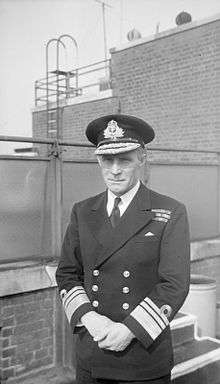Guy Royle
| Sir Guy Charles Cecil Royle | |
|---|---|
 Vice Admiral Royle as Chief of Australian Naval Staff during World War II | |
| Born | 17 August 1885 |
| Died | 4 January 1954 (aged 68) |
| Allegiance |
|
| Service/branch |
|
| Years of service | 1900–1945 |
| Rank | Admiral |
| Commands held |
Chief of the Australian Naval Staff HMS Canterbury HMS Excellent HMS Glorious |
| Battles/wars |
World War I World War II |
| Awards |
Knight Commander of the Order of the Bath Companion of the Order of St Michael and St George |
Admiral Sir Guy Charles Cecil Royle KCB, CMG, RN (17 August 1885 – 4 January 1954) was a Royal Navy officer who went on to be Fifth Sea Lord and First Naval Member of the Royal Australian Navy.
Naval career
Royle joined the Royal Navy with a commission as a midshipman in 1900.[1]
He served in World War I as Gunnery Officer on the battleship HMS Marlborough and was at the Battle of Jutland in 1916,[2] then on the staff of Admiral Sir Charles Madden in the Grand Fleet.[2] By 1919 he had been promoted Commander and in July 1919 was appointed a Companion of the Order of St Michael and St George "for valuable services as Gunnery officer of H. M. S. "Marlborough", 1st Battle Squadron, and as Flag Commander to the Admiral, Second in Command, Grand Fleet."[3]
Royle was appointed Assistant to the Deputy Director of Naval Ordnance in 1923 and became Naval attaché in Tokyo in 1924.[2] He was given command of the cruiser HMS Canterbury in 1927, the shore establishment HMS Excellent in 1930 and the aircraft carrier HMS Glorious in 1933.[2] He went on to be Naval Secretary from 1934 and to 1937, when he was appointed Vice Admiral commanding the aircraft carriers, serving until 1939. In World War II, he returned briefly as Naval Secretary from September to November, 1939, then until 1941 was Fifth Sea Lord and Chief of the Naval Air Service, when he became First Naval Member of the Australian Commonwealth Naval Board; he retired the service in 1946.[1][2]
Royle was knighted in 1941 and promoted admiral in 1942.[1]
In retirement he was appointed briefly as Secretary to the Lord Great Chamberlain and finally as Yeoman Usher (deputy) of the Black Rod,[4] a ceremonial position in the House of Lords, serving in that office from 1946 to 1953.[5] He collapsed and died while putting out a heath fire near his home at Wimborne Minster in Dorset.[6]
References
- 1 2 3 Winston Churchill, ed. Martin Gilbert, The Churchill War Papers: At the Admiralty, September 1939-May 1940 (1993), p. 354
- 1 2 3 4 5 Liddell Hart Centre for Military Archives
- ↑ London Gazette, Issue 31461 (supplement), 15 July 1919, Page 9107
- ↑ House of Lords Offices Hansard, 9 December 1953
- ↑ Black Rod, 1361- at parliament.uk, accessed 23 November 2010
- ↑ Admiral Sir Guy Royle Flight International, 15 January 1954
| Military offices | ||
|---|---|---|
| Preceded by Sidney Meyrick |
Naval Secretary 1934–1937 |
Succeeded by William Whitworth |
| Preceded by Sir Alexander Ramsay |
Fifth Sea Lord 1939–1941 |
Succeeded by Sir Lumley Lyster |
| Preceded by Admiral Sir Ragnar Colvin |
Chief of the Australian Naval Staff 1941–1945 |
Succeeded by Admiral Sir Louis Hamilton |
| ||||||||||||||||||||
